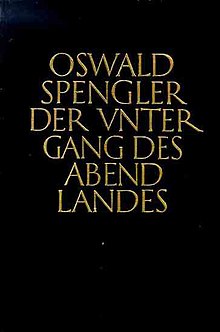
Back تدهور الحضارة الغربية (كتاب) Arabic Залезът на Запада Bulgarian Der Untergang des Abendlandes Danish Der Untergang des Abendlandes German La Subiro de la Okcidento Esperanto La decadencia de Occidente Spanish Õhtumaa allakäik Estonian انحطاط غرب Persian Länsimaiden perikato Finnish Le Déclin de l'Occident French
 Cover of Volume II, first edition, 1922 | |
| Author | Oswald Spengler |
|---|---|
| Original title | Der Untergang des Abendlandes |
| Translator | Charles Francis Atkinson |
| Language | German |
| Subject | Philosophy of history |
Publication date | 1918 (Vol.I); 1922 (Vol.II) |
| Publication place | Germany |
Published in English | 1926 |
| Media type | Print (hardcover and paperback) |
| Pages | 507 |
The Decline of the West (German: Der Untergang des Abendlandes; more literally, The Downfall of the Occident) is a two-volume work by Oswald Spengler. The first volume, subtitled Form and Actuality, was published in the summer of 1918.[1] The second volume, subtitled Perspectives of World History, was published in 1922.[2] The definitive edition of both volumes was published in 1923.[3]
Spengler introduced his book as a "Copernican overturning"—a specific metaphor of societal collapse—involving the rejection of the Eurocentric view of history, especially the division of history into the linear "ancient-medieval-modern" rubric.[4] According to Spengler, the meaningful units for history are not epochs but whole cultures which evolve as organisms. In his framework, the terms "culture" and "civilization" were given non-standard definitions and cultures are described as having lifespans of about a thousand years of flourishing, and a thousand years of decline. To Spengler, the natural lifespan of these groupings was to start as a "race"; become a "culture" as it flourished and produced new insights; and then become a "civilization". Spengler differed from others in not seeing the final civilization stage as necessarily "better" than the earlier stages; rather, the military expansion and self-assured confidence that accompanied the beginning of such a phase was a sign that the civilization had arrogantly decided it had already understood the world and would stop creating bold new ideas, which would eventually lead to a decline. For example, to Spengler, the Classical world's culture stage was in Greek and early Roman thought; the expansion of the Roman Empire was its civilization phase; and the collapse of the Roman and Byzantine Empires their decline. He believed that the West was in its "evening", similar to the late Roman Empire, and approaching its eventual decline despite its seeming power.
Spengler recognized at least eight high cultures: Babylonian, Egyptian, Chinese, Indian, Mesoamerican (Mayan/Aztec), Classical (Greek/Roman, "Apollonian"), the non-Babylonian Middle East ("Magian"), and Western or European ("Faustian"). Spengler combined a number of groups under the "Magian" label; "Semitic", Arabian, Persian, and the Abrahamic religions in general as originating from them (Judaism, Christianity, Islam). Similarly, he combined various Mediterranean cultures of antiquity including both Ancient Greece and Ancient Rome as "Apollonian", and modern Westerners as "Faustian". According to Spengler, the Western world was ending and the final season, the "winter" of Faustian Civilization, was being witnessed. In Spengler's depiction, Western Man was a proud but tragic figure because, while he strives and creates, he secretly knows the actual goal will never be reached.
- ^ Spengler, Oswald (1918). The Decline of the West, v. 1: Form and Actuality. pp. 6–7.
- ^ Spengler, Oswald (1922). Decline of the West v. 2: Perspectives of World History. pp. 9–10.
- ^ Baker, John Randal (1974). Race. Oxford University Press. p. 52. ISBN 978-0-19-212954-3. LCCN 73-87989.
- ^ Spengler O., Op.laud., vol.1, Intro. $6.